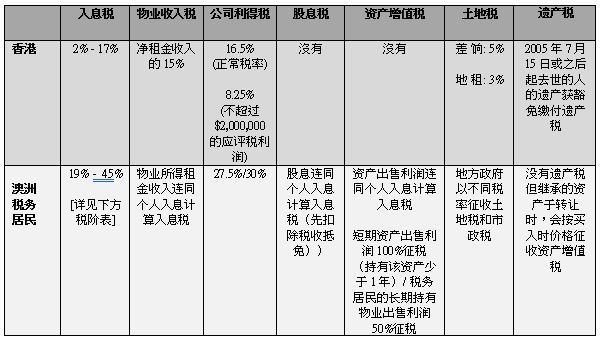1.澳洲与香港的税制的分别
香港
- 收入来源地域征税–即仅源自香港的个人收入和企业利润才须在香港征税,而源自其他地方的收入则不须在香港缴付利得/入息税。
澳洲
- 全球征税–澳大利亚税务居民在全球所赚取的收入和利润,包括得自海外的利润,都纳入征税。

2. 澳洲税制的简介
A. 全球征税制度 – 澳洲税务居民(Tax Resident) vs非税务居民 (Foreign Resident)
澳洲居民
- 如你是澳洲税务居民,便要为源自澳洲及海外的收入缴税。 「税务居民」按照澳洲税法定义,与居住日数、常居地、是否计划在澳洲定居等有关,与所持签证性质、是否已入籍等并无必然关系。仅持有非永居签证、甚至曾短暂逗留者,仍有机会被视为税务居民。
- 一般而言,只要你在每税收年度(7月1日至6月30日)于澳洲逗留多于183日,就定义为税务居民(Tax-Resident),除非你的常居地并非澳洲而你没有在澳洲定居的意图。
- 2020-21年度澳洲税务居民税率:
|
年收入稅階(澳元) |
稅率 |
|
$0 – $18,200 |
0 |
|
$18,201 – $37,000 |
19% |
|
$37,001 – $90,000 |
32.5% |
|
$90,001 – $180,000 |
37% |
|
$180,001 或以上 |
45% |
非税务居民 (Foreign Resident)
- 如你并非澳洲税务居民,便只需为源自澳洲的收入缴税。
- 2020-21年度非税务居民税率:
|
年收入稅階(澳元) |
稅率 |
|
$0 – $90,000 |
32.5% |
|
$90,001 – $180,000 |
37% |
|
$180,001 或以上 |
45% |
B. 香港与澳洲没有签定双边税务条约 (Double Taxation Agreement)
- 如果澳洲税务居民有来自香港的收入,该等收入会被双重征税,第一次是根据香港的地域来源征税原则被征税,另一次是在澳洲根据全球收入原则在澳洲被征税。
- 实际上已经向香港政府支付了针对香港收入的税项,并且该等收入已向澳洲政府申报为所得税的应纳税所得额,则可要求抵销该等已付税项的金额。
3. 移民前的税务计画
A. 对投资资产进行评估
- 在移民前应对所有投资资产进行正式评估,以确定对高于该估值的未来利润征税的价值。
- 简单来说,移民前的收益不受澳洲征税,移民后的收益则受澳洲征税,故应尽量安排于移民前赚取此收益。
B. 妥善运用澳洲负扣税 (Negative Gearing)
- 如将在澳洲定居或在澳洲产生收入,应妥善运用澳洲物业相关的负扣税制度,利用「支出」「亏损」等减免税务。
C. 设立信托
- 澳洲家庭信托或海外信托均能有效地达至税务递延甚至减免。
联络我们:

Anna Chan 陈韵祺律师
Partner 合伙人
anna.chan@oln-law.com
免責聲明:本文僅供參考。本文中的任何內容均不得解釋為對任何人提供的澳洲或香港法律意見或任何與此有關的法律意見。高李嚴律師事務所對任何人因本文所所載的任何內容而行所造成的任免责声明:本文仅供参考。本文中的任何内容均不得解释为对任何人提供的澳洲或香港法律意见或任何与此有关的法律意见。高李严律师事务所对任何人因本文所所载的任何内容而行所造成的任何损失和/或损害不承担任何责任。何損失和/或損害不承擔任何責任。
 香港中环雪厂街二号圣佐治大厦五楼503室
香港中环雪厂街二号圣佐治大厦五楼503室 +852 2868 0696
+852 2868 0696









